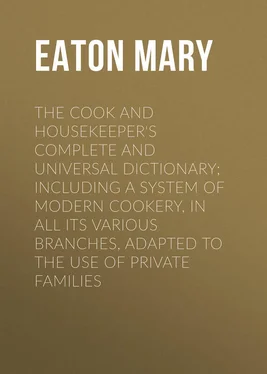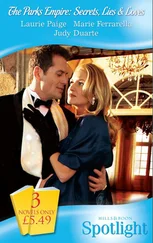Mary Eaton - The Cook and Housekeeper's Complete and Universal Dictionary; Including a System of Modern Cookery, in all Its Various Branches, Adapted to the Use of Private Families
Здесь есть возможность читать онлайн «Mary Eaton - The Cook and Housekeeper's Complete and Universal Dictionary; Including a System of Modern Cookery, in all Its Various Branches, Adapted to the Use of Private Families» — ознакомительный отрывок электронной книги совершенно бесплатно, а после прочтения отрывка купить полную версию. В некоторых случаях можно слушать аудио, скачать через торрент в формате fb2 и присутствует краткое содержание. Издательство: Иностранный паблик, Жанр: foreign_antique, foreign_prose, на английском языке. Описание произведения, (предисловие) а так же отзывы посетителей доступны на портале библиотеки ЛибКат.
- Название:The Cook and Housekeeper's Complete and Universal Dictionary; Including a System of Modern Cookery, in all Its Various Branches, Adapted to the Use of Private Families
- Автор:
- Издательство:Иностранный паблик
- Жанр:
- Год:неизвестен
- ISBN:нет данных
- Рейтинг книги:5 / 5. Голосов: 1
-
Избранное:Добавить в избранное
- Отзывы:
-
Ваша оценка:
- 100
- 1
- 2
- 3
- 4
- 5
The Cook and Housekeeper's Complete and Universal Dictionary; Including a System of Modern Cookery, in all Its Various Branches, Adapted to the Use of Private Families: краткое содержание, описание и аннотация
Предлагаем к чтению аннотацию, описание, краткое содержание или предисловие (зависит от того, что написал сам автор книги «The Cook and Housekeeper's Complete and Universal Dictionary; Including a System of Modern Cookery, in all Its Various Branches, Adapted to the Use of Private Families»). Если вы не нашли необходимую информацию о книге — напишите в комментариях, мы постараемся отыскать её.
The Cook and Housekeeper's Complete and Universal Dictionary; Including a System of Modern Cookery, in all Its Various Branches, Adapted to the Use of Private Families — читать онлайн ознакомительный отрывок
Ниже представлен текст книги, разбитый по страницам. Система сохранения места последней прочитанной страницы, позволяет с удобством читать онлайн бесплатно книгу «The Cook and Housekeeper's Complete and Universal Dictionary; Including a System of Modern Cookery, in all Its Various Branches, Adapted to the Use of Private Families», без необходимости каждый раз заново искать на чём Вы остановились. Поставьте закладку, и сможете в любой момент перейти на страницу, на которой закончили чтение.
Интервал:
Закладка:
BUTTERMILK, if made of sweet cream, is a delicious and very wholesome article of food. Those who can relish sour buttermilk, will find it still more light, and it is reckoned very beneficial in consumptive cases. If not very sour, it is also as good as cream to eat with fruit; but it should be sweetened with white sugar, and mixed with a very little milk. It does equally well for cakes and rice puddings, and of course it is economical to churn before the cream is too stale for any thing but to feed pigs. – The celebrated Dr. Boerhaäve recommended the frequent use of sweet buttermilk in all consumptive cases, and that it should form the whole of the patient's drink, while biscuits and rusks, with ripe and dried fruits of various kinds, should chiefly be depended on as articles of food. For this purpose take the milk from the cow into a small churn; in about ten minutes begin churning, and continue till the flakes of butter swim about pretty thick, and the milk is discharged of all the oily particles, and appears thin and blue. Strain it through a sieve, and let the patient drink it as frequently as possible.
BUTTERMILK PUDDING. Warm three quarts of new milk, turn it with a quart of buttermilk, and drain the curd through a sieve. When dry pound in a marble mortar, with nearly half a pound of sugar, a lemon boiled tender, the crumb of a roll grated, a nutmeg grated, six bitter almonds, four ounces of warm butter, a tea-cupful of good cream, the yolks of five and whites of three eggs, a glass of sweet wine and a glass of brandy. When well incorporated, bake in small cups or bowls well buttered. If the bottom be not brown, use a salamander; but serve as quick as possible, and with pudding sauce.
BUTTERED CRABS. Pick out the inside when boiled, beat it up in a little gravy, with wine, pepper, salt, nutmeg, a few crumbs of bread, a piece of butter rolled in a little flour, and some vinegar or lemon juice. Serve it up hot.
BUTTERED EGGS. Beat four or five eggs, yolk and white together; put a quarter of a pound of butter in a bason, and then put that into boiling water. Stir it till melted, then put that butter and the eggs into a saucepan; keep a bason in your hand, just hold the saucepan in the other over a slow part of the fire, shaking it one way, as it begins to warm. Pour it into the bason and back again, then hold it over the fire, stirring it constantly in the saucepan, and pouring it into the bason, more perfectly to mix the egg and butter, until they shall be hot without boiling. Serve on toasted bread, or in a bason, to eat with salt fish or red herrings.
BUTTERED LOAF. Take three quarts of new milk, and add as much rennet as is sufficient to turn it; then break the curd, and drain off all the whey through a clean cloth. Pound it in a stone mortar, add the white of one and the yolks of six eggs, a good handful of grated bread, half as much of fine flour, and a little salt. Mix them well together with the hand, divide the whole into four round loaves, and place them upon white paper. After they are well buttered, varnish them all over with a feather, dipped in the yolk of an egg stirred up with a little beer. Set the loaves in a quick oven three quarters of an hour; while baking, take half a pound of new butter, add to it four spoonfuls of water, half a nutmeg grated, and sugar sufficient to sweeten it. Stir them together over the fire till they boil; when sufficiently thickened, draw the loaves from the oven, open their tops, pour in the butter and sugar, and send them up with sugar strewed over them.
BUTTERED LOBSTERS. Pick out the meat, cut and warm it, with a little weak brown gravy, nutmeg, salt, pepper, butter, and a little flour. If done white, a little white gravy and cream.
BUTTERED ORANGES. Grate off a little of the outside rind of four Seville oranges, and cut a round hole at the blunt end opposite the stalk, large enough to take out the pulp and seeds and juice. Then pick the seeds and skin from the pulp, rub the oranges with a little salt, and lay them in water for a short time. The bits cut out are to be saved. Boil the fruit in fresh water till they are tender, shifting the water to take out the bitterness. In the meantime make a thin syrup with fine sugar, put the oranges into it, and boil them up. As the quantity of syrup need not be enough to cover them, turn them round, that each part may partake of the syrup, and let them remain in it hot till they are wanted. About half an hour before serving, put some sugar to the pulp, and set it over the fire; mix it well, and let it boil. Then add a spoonful of white wine for every orange, give it a boil, put in a bit of fresh butter, and stir it over the fire to thicken. Fill the oranges with it, and serve them with some of the syrup in the dish, with the bits on the top.
BUTTERED ORANGE-JUICE. Mix the juice of seven Seville oranges with four spoonfuls of rose-water, and add the yolks of eight and the whites of four eggs well beaten. Strain the liquor on half a pound of sugar pounded, stir it over a gentle fire; and when it begins to thicken, add a piece of butter the size of a small walnut. Keep it over the fire a few minutes longer, then pour it into a flat dish, and serve it to eat cold. If no silver saucepan for the purpose, do it in a china bason in a saucepan of boiling water, the top of which will just receive the bason.
BUTTERED PRAWNS. Take them out of the husk; warm them with a little good gravy, a bit of butter and flour, a taste of nutmeg, pepper and salt. Simmer them together a minute or two, and serve with sippets; or with cream sauce, instead of brown. Shrimps are done in the same manner.
BUTTERED RICE. Wash and pick some rice, drain, and set it on the fire, with new milk sufficient to make it swell. When tender, pour off the milk, and add a bit of butter, a little sugar and pounded cinnamon. Shake and keep it from burning on the fire, and serve it up as a sweet dish.
C
Cabbage. Wash and pick it carefully, and if very large, quarter it. Put it into a saucepan with plenty of boiling-water, and a large spoonful of salt; if any scum rises, take it off, and boil it till the stalk is tender. Keep the vegetable well covered with water all the time of boiling, and see that no smoke or dirt arises from stirring the fire. With careful management the cabbage will look as beautiful when dressed, as it did when growing. The flavour of an old cabbage may be much improved, by taking it up when half done, and putting it directly into another saucepan of fresh boiling water. When taken up, drain it in a cullender. It may be chopped and warmed with a piece of butter, pepper and salt, or sent to table whole with melted butter. Savoys and greens in general are dressed in the same way.
CAKES. In making and baking cakes the following particulars should be attended to. The currants should be nicely picked and washed, dried in a cloth, and set before the fire. If damp, they will make cakes or puddings heavy. Before they are added, a dust of dry flour should be scattered among them, and then shaken together, which will make the cake or pudding lighter. Eggs should be beaten a long time, whites and yolks apart, and always strained. Sugar should be rubbed to a powder on a clean board, and sifted through a fine hair or lawn sieve. Lemon peel requires to be pared very thin, and with a little sugar beaten to a paste in a marble mortar. It should then be mixed with a little wine or cream, so as to divide easily among the other ingredients. After all the articles are put into the pan, they should be long and thoroughly beaten, as the lightness of the cake depends much on their being well incorporated. Both black and white plumb cakes, being made with yeast, require less butter and eggs, and eat equally light and rich. If the leaven be only of flour, milk and water, and yeast, it becomes more tough, and is less easily divided, than if the butter be first put with those ingredients, and the dough afterwards set to rise by the fire. The heat of the oven is of great importance for cakes, especially large ones. If not pretty quick, the batter will not rise; and if too quick, put some white paper over the cake to prevent its being burnt. If not long enough lighted to have a body of heat, or it is become slack, the cake will be heavy. To know when it is soaked, take a broad-bladed knife that is very bright, and thrust it into the centre; draw it out instantly, and if the paste in any degree adheres, return the cake to the oven, and close it up. If the heat is sufficient to raise but not to soak the baking, a little fresh fuel should be introduced, after taking out the cakes and keeping them hot, and then returning them to the oven as quickly as possible. Particular care however should be taken to prevent this inconvenience, when large cakes are to be baked.
Читать дальшеИнтервал:
Закладка:
Похожие книги на «The Cook and Housekeeper's Complete and Universal Dictionary; Including a System of Modern Cookery, in all Its Various Branches, Adapted to the Use of Private Families»
Представляем Вашему вниманию похожие книги на «The Cook and Housekeeper's Complete and Universal Dictionary; Including a System of Modern Cookery, in all Its Various Branches, Adapted to the Use of Private Families» списком для выбора. Мы отобрали схожую по названию и смыслу литературу в надежде предоставить читателям больше вариантов отыскать новые, интересные, ещё непрочитанные произведения.
Обсуждение, отзывы о книге «The Cook and Housekeeper's Complete and Universal Dictionary; Including a System of Modern Cookery, in all Its Various Branches, Adapted to the Use of Private Families» и просто собственные мнения читателей. Оставьте ваши комментарии, напишите, что Вы думаете о произведении, его смысле или главных героях. Укажите что конкретно понравилось, а что нет, и почему Вы так считаете.












![John Bruce - The Lettsomian Lectures on Diseases and Disorders of the Heart and Arteries in Middle and Advanced Life [1900-1901]](/books/749387/john-bruce-the-lettsomian-lectures-on-diseases-and-disorders-of-the-heart-and-arteries-in-middle-and-advanced-life-1900-1901-thumb.webp)